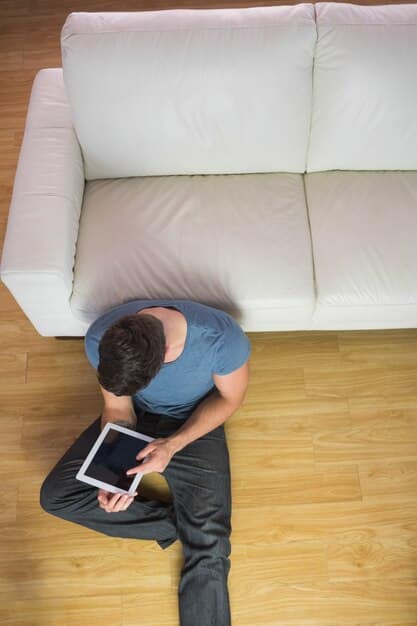Understanding SAD: A Winter 2025 Guide for Men’s Mental Health

Understanding Seasonal Affective Disorder (SAD) in men involves recognizing the unique symptoms, implementing effective coping strategies, and seeking professional help to navigate the challenges posed by winter’s shorter days and reduced sunlight in 2025.
As winter approaches in 2025, understanding the impact of shorter days on mental health is crucial, especially for men. This guide delves into Understanding Seasonal Affective Disorder (SAD): A Guide for Men in Winter 2025, offering insights and strategies to navigate this challenging season.
What is Seasonal Affective Disorder (SAD)?
Seasonal Affective Disorder (SAD) is more than just the “winter blues.” It’s a type of depression that’s related to changes in seasons, beginning and ending at about the same times every year. Understanding this cyclical pattern is the first step in managing its effects.
SAD typically occurs in the late fall or early winter and goes away during the sunnier days of spring and summer. The decreased sunlight can disrupt your body’s internal clock, leading to feelings of depression.
Symptoms of SAD
The symptoms of SAD can range from mild to severe and can be debilitating. It’s important to recognize these symptoms and differentiate them from general feelings of sadness. These symptoms include:
- Persistent low mood
- Loss of interest or pleasure in activities you once enjoyed
- Changes in appetite, often craving foods high in carbohydrates
- Changes in sleep patterns, often experiencing excessive sleepiness

Recognizing these symptoms is key to seeking help and managing SAD effectively. Early intervention can significantly improve outcomes.
In conclusion, understanding the basics of SAD, including its cyclical nature and common symptoms, is crucial for identifying and addressing the condition, especially as winter approaches. Knowing what to look for can empower individuals to take proactive steps towards managing their mental health.
SAD Symptoms in Men: What to Look For?
While SAD shares common symptoms across genders, men may experience them differently. Recognizing these unique manifestations is vital for accurate identification and effective coping.
Men might be less likely to express feelings of sadness or hopelessness openly. Instead, they may exhibit increased irritability, fatigue, or a loss of interest in work or hobbies.
Common Signs in Men
It’s crucial to understand the specific ways SAD can manifest in men. While depression is a common symptom, men may experience it differently. Some typical signs include:
- Increased irritability or agitation
- A tendency to withdraw from social activities
- Physical symptoms such as headaches or digestive problems
- An increase in substance use, such as alcohol or drugs
It’s important to note that these symptoms can be subtle and easily dismissed as stress or fatigue, highlighting the importance of awareness and self-monitoring.
In summary, being aware of the subtle yet significant differences in how SAD manifests in men is crucial for early detection and effective management, contributing to better mental health outcomes.
Why SAD Affects Men Differently
The reasons behind the varying experience of SAD between men and women are multifaceted. Biological, social, and cultural factors all play a significant role.
Hormonal differences, variations in coping mechanisms, and societal expectations can all contribute to how SAD affects men. The societal pressure to maintain a strong and stoic facade can hinder men from seeking help.
The Role of Testosterone
Testosterone plays a critical role in men’s mood regulation. Fluctuations in hormone levels during the winter months may exacerbate SAD symptoms.
- Reduced sunlight exposure can affect testosterone levels
- Lower testosterone can lead to fatigue, irritability, and depression
- Maintaining healthy testosterone levels can improve mood

Understanding the hormonal aspects of SAD in men is crucial for developing targeted treatment strategies. Hormone therapy and lifestyle adjustments can help improve mood and energy levels.
In conclusion, recognizing the interplay of biological, social, and cultural factors that influence how SAD affects men is essential. By addressing these unique dynamics, we can develop more effective and tailored approaches to support their mental health.
Effective Strategies for Coping with SAD in Winter 2025
Coping with SAD involves a multifaceted approach, combining lifestyle adjustments, therapeutic interventions, and proactive self-care techniques. These strategies can help mitigate the impact of reduced sunlight and seasonal changes on mental health.
Light therapy, regular exercise, and maintaining a balanced diet are all effective ways to combat SAD. It’s also important to prioritize self-care activities and seek support from friends, family, or professionals.
Practical Tips for Men
Men can take a number of practical steps to cope with SAD effectively. These strategies focus on maintaining physical and mental well-being throughout the winter months.
- Light Therapy: Use a light therapy box to simulate natural sunlight.
- Regular Exercise: Engage in physical activity to boost mood and energy levels.
- Balanced Diet: Eat a healthy diet rich in vitamins and minerals.
The key is to integrate these practices into your daily routine and adjust them as needed to meet your specific needs and preferences.
Overall, adopting a comprehensive approach to coping with SAD, including practical tips and therapeutic interventions, can empower men to navigate the challenges of winter with greater resilience and improved well-being.
When to Seek Professional Help
Knowing when to seek professional help for SAD is crucial. Recognizing the signs that indicate the need for intervention can prevent symptoms from escalating and improve long-term outcomes.
If symptoms are severe, persistent, or interfering with daily life, it’s important to consult a healthcare professional. Therapy, medication, and other treatments can help manage SAD effectively.
Finding the Right Therapist
Finding a therapist who understands SAD and the unique challenges men face is essential. A good therapist can provide support, guidance, and evidence-based treatments.
When seeking a therapist, consider the following:
- Look for therapists with experience in treating mood disorders.
- Inquire about their approach to treating SAD, including therapy and medication options.
- Trust your gut: choose someone you feel comfortable talking to and can open up to.
Remember, seeking help is a sign of strength, not weakness. A qualified therapist can provide the support and tools needed to manage SAD effectively.
In summary, recognizing the signs that indicate the need for professional help and taking proactive steps to find the right therapist are essential for managing SAD effectively and improving overall mental well-being.
Lifestyle Adjustments to Combat SAD
In addition to therapy and medication, lifestyle adjustments play a crucial role in managing SAD. Simple changes in your daily routine can have a significant impact on mood and energy levels.
Prioritizing sleep, managing stress, and engaging in social activities are all important lifestyle adjustments. Creating a supportive environment and practicing mindfulness can also help.
The Importance of a Routine
Establishing a daily routine can provide structure and stability during the winter months. This can help regulate your body’s internal clock and improve mood.
Here are some tips for creating a routine:
- Set a consistent sleep schedule, going to bed and waking up at the same time each day.
- Plan regular meals and snacks to maintain stable energy levels.
- Schedule time for exercise, social activities, and self-care.
Consistency is key. Sticking to a routine can help reduce feelings of anxiety and depression, promoting a sense of control and well-being.
In conclusion, making thoughtful lifestyle adjustments, such as prioritizing sleep, managing stress, and establishing a consistent routine, can significantly enhance your ability to combat SAD. These changes, when combined with professional support, can create a holistic approach to mental wellness during the winter months.
| Key Point | Brief Description |
|---|---|
| 💡Symptoms Awareness | Recognize unique SAD symptoms in men, like irritability. |
| ☀️Light Therapy | Use a light box to simulate sunlight and boost mood. |
| 💪Physical Activity | Engage in regular exercise to increase energy levels. |
| 👨⚕️Professional Help | Seek therapy if symptoms are severe or interfere with daily life. |
Frequently Asked Questions (FAQ)
▼
Seasonal Affective Disorder (SAD) is a mood disorder characterized by depression that occurs at the same time each year. It typically starts in the fall and continues through the winter months, correlating with reduced sunlight.
▼
SAD is a subtype of depression that follows a seasonal pattern. Symptoms occur during specific times of the year and improve during other seasons, unlike regular depression, which can occur at any time.
▼
Use a light therapy box that emits 10,000 lux of light. Sit 16-24 inches away for about 20-30 minutes each morning. Ensure the light enters your eyes indirectly, and consult with a healthcare provider for guidance.
▼
Yes, diet can influence SAD symptoms. Consuming a balanced diet with plenty of fruits, vegetables, and whole grains can improve mood and energy levels, while limiting processed foods and sugars can help stabilize blood sugar.
▼
Yes, various support groups cater to individuals with SAD. Online forums, local community centers, and mental health organizations often provide resources and support networks specifically designed for men experiencing SAD symptoms.
Conclusion
Understanding Seasonal Affective Disorder (SAD): A Guide for Men in Winter 2025 is essential for proactive mental health management. By recognizing symptoms, implementing coping strategies, and seeking professional help when needed, men can navigate the challenges of SAD and maintain their well-being throughout the winter months.





